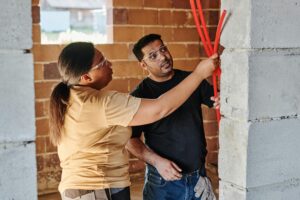Home inspections are an opportunity to get the opinion of an impartial, outside professional who provides information about the condition of a home. Here are answers to common questions about the home inspection process so you know what to expect.
 Do You Have To Get A Home Inspection?
Do You Have To Get A Home Inspection?
While home inspections are generally recommended when buying or selling a home, they are typically not required unless an inspection contingency is included in the purchase contract. The terms of some mortgages may require you to have an inspection. A home inspection differs from a home appraisal, which is almost always needed when taking out a mortgage loan.
If you waive an inspection as a buyer, any problems arising after the sale will generally be your responsibility.
What Does A Home Inspector do?
A home inspector is a trained professional who visually inspects the structure and accessible components of a home to identify any immediate or potential problems. They should provide a complete report with photographs and descriptions of any problem areas and may also include recommendations for further evaluation. You can review the home inspection report with your real estate broker to decide how the results could affect your potential home purchase.
What Does A Home Inspection Include?
Home inspection requirements vary widely from state to state, and these standards of practice outline the minimum, uniform standards you can expect from an inspection. Some of the areas inspected typically include:
Structural elements: Any evidence of subsidence or tilting of the structure, as well as the construction of visible foundations, floors, walls, roofs, stairs, drainage systems, and window alignment.
Safety: The condition of stairs, handrails, alarms (fire and carbon monoxide ), and fire sprinklers.
Land: Drainage is adequate, and the septic tank is functioning; the condition of the entrances, fences, and sidewalks of the home.
Roof: The condition of shingles, flashings, and chimneys (including any repairs/patches to flat roofs); Ensure vents are free of obstructions and gutters are functioning correctly.
 Exterior Surfaces: Adequate clearance between the floor and exterior siding material, exterior paint or wall covering condition, and properly functioning lights and electrical outlets.
Exterior Surfaces: Adequate clearance between the floor and exterior siding material, exterior paint or wall covering condition, and properly functioning lights and electrical outlets.
Attic: There is sufficient insulation and adequate ventilation; any signs of drips or water damage.
Indoor Plumbing: There are no leaking or damaged pipes, the hot water temperature is appropriate, and toilets, sinks, bathtubs, and showers are functioning.
Electrical System: The condition of the visible wiring, ensuring that it complies with building codes and adequately functions the fuse box, plugs, lamps, and fans.
Appliances: The operation of built-in and freestanding appliances (stove, dishwasher, refrigerator, microwave, washer and dryer, and all other appliances).
Heating And Cooling Systems: The condition of the heating, air conditioning (temperature permitting), boiler, and chimney.
Basement: The foundation, walls, and floors are solid, with no signs of leaks or water damage.
Garage: The condition of the foundation, windows, roof, frame, and roof; that the electrical system and outlets comply with building codes. Make sure the garage door and garage door opener work.
Insulation: Provide adequate insulation in unfinished areas, including foundations and low-rise basements. Ventilation: Ventilation systems function in the kitchen, bathroom, and laundry areas, and fans are present.

